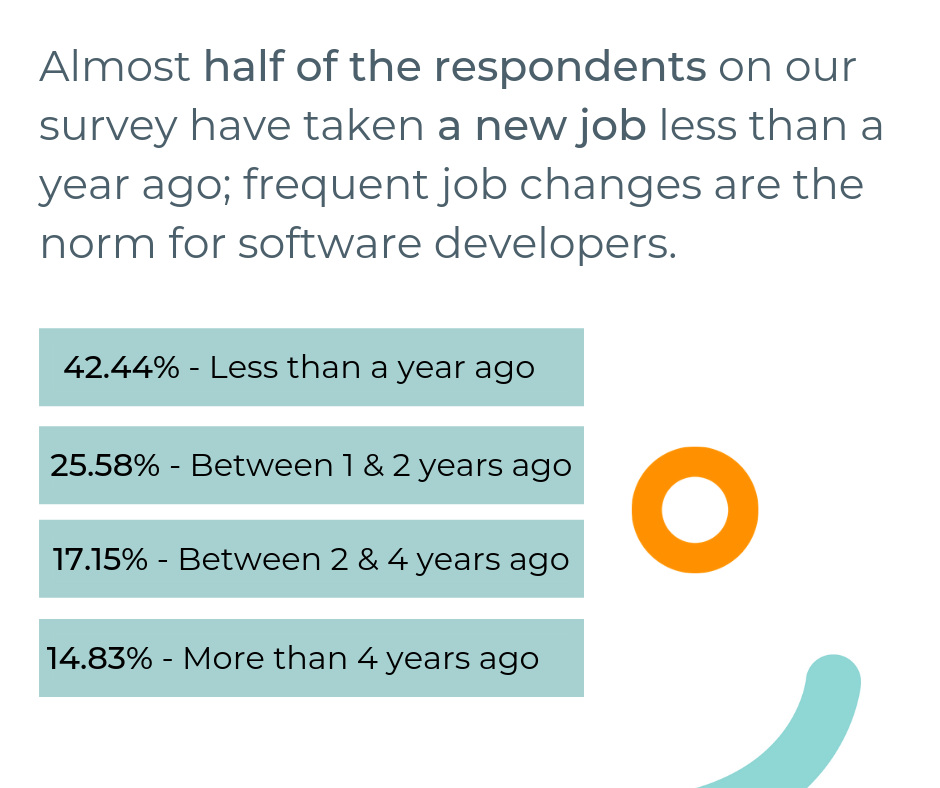Hiring
13 Signs Your Top Talent May Soon Leave

When your lead DevOps engineer suddenly stops proposing infrastructure improvements or your senior full-stack developer starts declining architect meetings, you’re witnessing more than a temporary slump. These are early indicators that your top talent retention strategy needs immediate attention.
In today’s competitive tech landscape, losing a key engineer can cost companies between $75,000 to $150,000 in replacement costs alone—not counting the project delays, knowledge gaps, and team morale impact that follows. The current shortage of experienced developers means that once top performers decide to leave, they typically have multiple offers within weeks.
Let’s examine the 13 most reliable warning signs that your star performers are preparing their exit, and more importantly, how to address them before it’s too late.
Why Top Talent Retention Matters More Than Ever in Tech
The remote-first revolution has fundamentally changed how developers view career mobility. Your senior React engineer no longer needs to relocate to Silicon Valley for better opportunities—they can interview with companies worldwide from their home office. This shift has created unprecedented competition for technical talent.
The real cost of turnover extends beyond recruitment:
- Knowledge drain: Senior engineers carry critical system knowledge and architectural decisions
- Project disruption: Key features get delayed while new hires ramp up
- Team velocity impact: Remaining team members struggle with increased workload during transitions
- Cultural erosion: High turnover signals instability to remaining staff
13 Critical Warning Signs Your Top Talent Is Preparing to Leave
1. They Stop Advocating for Technical Improvements
Previously, your senior engineer championed migrating to React 18 or upgrading your Kubernetes cluster. Now they’ve gone silent on technical initiatives. This shift from proactive problem-solving to passive acceptance often signals mental checkout—they’re saving their energy for their next role.
What it means: They no longer see long-term value in investing effort to improve systems they won’t be maintaining.
2. Meeting Participation Drops Dramatically
Your usually vocal architect stops contributing to design discussions. They attend sprint planning but offer minimal input on story estimation. This withdrawal from collaborative decision-making indicates they’re already mentally transitioning away from team responsibilities.
Tech-specific red flag: When they stop asking questions about upcoming features or expressing opinions on technical approaches.
3. Increased “Sick Days” and Mysterious Absences
Sudden upticks in time-off requests, especially during typical business hours (9-5), often indicate interview scheduling. In remote work environments, watch for unusual calendar blocking or decreased Slack responsiveness during core collaboration hours.
Modern indicator: They’re less available for impromptu video calls or seem distracted during virtual meetings.
4. Social Engagement Within the Team Diminishes
The developer who previously shared interesting GitHub repositories or participated in technical discussions now remains quiet in team channels. They skip optional team events or virtual coffee chats they previously enjoyed.
Remote work signal: Reduced participation in informal Slack channels or team gaming sessions.
5. Recent Career Development Disappointments
They were passed over for a senior or lead engineer position, or their request for conference attendance was denied. In competitive tech markets, top performers expect clear advancement paths—stagnation drives them toward companies offering growth opportunities.
Critical moment: When promotion cycles or salary reviews don’t meet expectations of high performers.
6. Loss of Interest in Professional Growth
Your previously ambitious developer stops pursuing new certifications, avoids learning emerging technologies, or declines opportunities to mentor junior team members. This disengagement from skill development often precedes departure.
Warning sign: They stop contributing to technical blogs, open source projects, or speaking at meetups.
7. Technical Stagnation in Their Current Role
They’ve mastered their current tech stack but aren’t being challenged with new problems. A senior Python developer stuck maintaining legacy code while wanting to explore machine learning will eventually seek opportunities elsewhere.
Context: The AI revolution is creating demand for engineers to expand into ML/AI, those feeling stuck in traditional roles are prime flight risks.
8. Decreased Code Quality and Productivity
Their usually clean, well-documented code becomes rushed. Pull requests lack thorough descriptions. They’re present but not fully engaged, classic signs of “quiet quitting” before actual resignation.
Technical indicators: Reduced code comments, minimal testing, or taking shortcuts they previously avoided.
9. They Stop Proposing Solutions and Innovations
The engineer who once suggested implementing automated testing or improving CI/CD pipelines now stays quiet during technical planning. Loss of innovative thinking indicates they’re reserving creative energy for their next opportunity.
Red flag: No longer participating in hackathons, innovation days, or proof-of-concept discussions.
10. Interpersonal Conflicts Increase
Previously collaborative team members become irritable with code review feedback or show frustration with project management decisions. When technical disagreements become personal, it often signals deeper job satisfaction issues.
Team dynamic warning: Increased tension during stand-ups or technical discussions.
11. They Start Offloading Responsibilities
Suddenly delegating tasks they previously handled personally, especially knowledge-heavy responsibilities like deployment procedures or system maintenance. They’re preparing others to take over their duties.
Critical sign: Training others on systems only they typically manage, especially without formal succession planning.
12. Strict Adherence to Working Hours
The developer who previously stayed late for deployments or joined weekend troubleshooting calls now maintains rigid 9-5 boundaries. While work-life balance is healthy, sudden changes often indicate decreased investment in company success.
Remote work indicator: Immediate Slack status changes to “away” at exactly 5 PM, or delayed responses to urgent technical issues.
13. Increased Complaints About Technical Debt
Previously patient senior engineers start vocalizing frustrations about legacy systems, poor code quality, or technical decisions. This shift from problem-solving to problem-complaining often precedes resignation.
Final warning: When they stop suggesting solutions and only highlight problems.

Proactive Strategies for Top Talent Retention
Implement Regular Technical Career Conversations
Schedule monthly one-on-ones focused specifically on career growth and technical interests. Ask about technologies they want to explore, projects that excite them, and skills they want to develop.
Key questions:
- “What emerging technologies interest you?”
- “Are there projects you’d like to lead?”
- “How can we better utilize your expertise?”
Create Clear Technical Career Pathways
Map out advancement opportunities beyond just management tracks. Offer principal engineer, architect, or technical lead paths that allow senior developers to grow without leaving hands-on development.
Provide Learning and Conference Budgets
Invest in their professional development with conference attendance, online courses, or certification programs. Top performers expect companies to invest in their growth.
Offer Technical Variety and Challenges
Rotate engineers through different projects, allow exploration of new tech stacks, or create innovation time (like Google’s 20% time) for experimental projects.
Address Technical Debt Systematically
Nothing frustrates good engineers more than being forced to work with poor-quality systems indefinitely. Dedicate sprint capacity to addressing technical debt and system improvements.
When Prevention Fails: Damage Control Strategies
Conduct Meaningful Exit Interviews
Focus on technical and cultural factors that drove their decision. Ask specifically about:
- Technical challenges that weren’t addressed
- Tools or technologies they wanted to work with
- Management or process frustrations
Knowledge Transfer Planning
Ensure critical system knowledge is documented and transferred before departure. This includes:
- Architecture documentation
- Deployment procedures
- System maintenance knowledge
- Code review and development standards
Team Morale Protection
Address remaining team concerns quickly. Departures can create anxiety about company stability—communicate openly about succession plans and team support.
The Current Tech Talent Reality
Remote work has expanded the talent pool globally, but it’s also increased competition for top performers. Companies competing for senior engineers aren’t just local anymore—they’re competing with organizations worldwide offering compelling remote opportunities.
The rise of AI and machine learning has created new categories of highly sought-after roles. Engineers with experience in prompt engineering, LLM integration, or AI-assisted development workflows are particularly mobile in today’s market.
Market insight: Companies offering cutting-edge technical challenges, clear advancement paths, and remote flexibility are winning the talent retention game.
Early Detection Enables Retention
Top talent retention starts with recognizing early warning signs and addressing root causes before employees mentally check out. The 13 signals outlined above provide a framework for identifying at-risk performers while there’s still time to re-engage them.
The key is moving beyond superficial retention tactics (ping pong tables and free snacks) toward meaningful career development, technical challenges, and growth opportunities that keep top performers intellectually engaged.
Action items for tech leaders:
- Audit your current team against these warning signs
- Schedule technical career conversations with your top performers this month
- Review advancement pathways to ensure they match engineer aspirations
- Assess technical debt levels that might be frustrating your best engineers
- Create systematic approaches for addressing the warning signs you identify
Remember: in today’s competitive market, retention is significantly more cost-effective than replacement. The investment in keeping your top talent engaged pays dividends in team stability, project continuity, and organizational knowledge preservation.
Ready to strengthen your technical team retention strategy? Let’s discuss how market-informed approaches to developer engagement can keep your top performers invested in your company’s future.